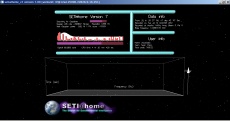“SETI@home”的版本间差异
小 (→'''项目成果''') |
小 (→'''项目成果''') |
||
| 第39行: | 第39行: | ||
=='''项目成果'''== | =='''项目成果'''== | ||
| − | [[Image:Bouncywikilogo_100px.gif|right|thumb|如果你希望有更深入的了解,英文维基百科有一个主题关于:[http://en.wikipedia.org/wiki/Extraterrestrial_intelligence | + | [[Image:Bouncywikilogo_100px.gif|right|thumb|如果你希望有更深入的了解,英文维基百科有一个主题关于:[http://en.wikipedia.org/wiki/Extraterrestrial_intelligence 外星生命]]] |
| − | 虽然项目至此还没有发现任何 | + | 虽然项目至此还没有发现任何 ETI(外星生命)的信号,但已经确认了天空中的几个候选目标作进一步的分析,如在峰值强度上不容易解析的干扰点([http://seticlassic.ssl.berkeley.edu/candidates.html nosiespots])。其中最重要的候选信号是公布于 2004 年 9 月 1 日,命名为 [[SHGb02+14a 的无线电源]]。 |
2009年10月17日 (六) 09:54的版本
|
SETI@home | |
|---|---|
| 文件:SaH logo.gif SETI@home logo | |
 Multi-Beam 任务的运行界面 | |
| 开发者 | 加利福尼亚州大学伯克利分校,空间科学实验室 |
| 版本历史 | 1999年5月17日 以独立运算平台公开运行,对独立平台的计算程序称为 SETI@home Classic 。 2005年8月27日 开启基于 BOINC 平台的计算程序。 2005年12月15日 结束独立运算平台的 SETI@home Classic。 2006年5月3日 开始新程序版本并运算新任务的 SETI@home Enhanced,该程序于2007年8月更名为 Multi-Beam。 2008年7月中旬 融入 Astropulse 计算任务。 2008年12月18日 开始支持 CUDA 的 GPU 计算程序,运行 Multi-Beam 任务。 |
| 运算平台 | Windows/Linux/Mac |
| 项目平台 | BOINC |
| 程序情况 | |
| 任务情况 | Multibeam子项目每个任务文件256KB,限期7日。 Astropulse子项目每个任务文件8,192KB,限期30日。 |
| 项目状态 | 运行中/开放注册 |
| 项目类别 | 物理与天文学 |
| 优化程序 | SETI@home:优化程序 |
| 计算特点 | CPU密集: |
| 官方网址 | SETI@home |
| [{{{rss}}} 通过 RSS 获取项目新闻] | |
SETI@home(Search for ExtraTerrestrial Intelligence at Home,在家搜寻外星智慧(地外文明---也就是我们常说的“外星人”)),是一个通过互联网利用家用个人计算机处理天文数据的分布式计算项目。该项目试图通过分析阿雷西博射电望远镜采集的无线电信号,搜寻能够证实外星智能生物存在的证据。该项目由美国加州大学伯克利分校的空间科学实验室主办。
科学研究
SETI@home 的原始目标有两个,第一个是要证明分布式计算概念的可行性和实用性。第二个是本身SETI的有益科学研究,以科学方法分析、探索地球以外的智慧生命。
其中第一个目标已经被普遍认为是完全成功的。由 SETI@home 发展开始到现在的 BOINC 环境,在广泛的科研领域支持了大量计算密集型的项目。
第二个目标至今未能实现:SETI@home 未能找到证明来自地外文明信号的证据。但是,项目仍继续探索,不断更新设备及分析办法来查找信号。
SETI@home 是通过分析来自阿雷西博天文台的射电望远镜收集的数据来寻找地球以外文明生命的证据。它是以“被背负”或者说“被动地”的形式当其他科学项目在利用望远镜的时候顺便获取数据。数据会被数据化存储,并发送到 SETI@home 总部。这些数据会根据频率和时间被分解成小块,通过软件进行分析,从可能含有信息的背景噪音中寻找所有信号。SETI@home 需要把每份数据分解数以百万计的小块,然后发送给家用电脑分析,并让软件返回计算结果。以互联网为基础的社会对这项繁重的数据分析提供了帮助。
计算程序会从搜索以下5种有别于噪声的信号:
- 峰值的谱密度
- 信号能力的高斯上升和下降,这种信号可能表示望远镜的接收器略过一个信号源。
- 三连波信号,连续的三个等距峰值信号。
- 窄带脉冲信号,可能在窄带上的数字信号。
- 广域极短脉冲,覆盖到脉冲星及原生黑洞的信号。详细请查看 Astropulse。
除此以外星际介质和星体的相对运动还会让信号出现很多其他的变化,这些潜在的“信号”会用若干办法进行处理,而 SETI@home 的计算程序也会在一定程度上对这些加工过的数据进行分析。
项目成果

虽然项目至此还没有发现任何 ETI(外星生命)的信号,但已经确认了天空中的几个候选目标作进一步的分析,如在峰值强度上不容易解析的干扰点(nosiespots)。其中最重要的候选信号是公布于 2004 年 9 月 1 日,命名为 SHGb02+14a 的无线电源。
Astronomer Seth Shostak has stated in 2004 that he expects to get a conclusive signal and proof of alien contact between 2020 and 2025, based on the Drake equation. This implies that a prolonged effort may
benefit SETI@home, despite its (present) nearly ten-year run without success in ETI detection.
While the project hasn't reached the goal of finding extraterrestrial intelligence, it has proved to the scientific community that distributed computing projects using Internet-connected computers can succeed as a viable analysis tool, and even beat the largest supercomputers. However, it has not been demonstrated that the order of magnitude excess in computers used, many outside the home (the original intent was to use 50,000-100,000 "home" computers), has benefited the project scientifically. (For more on this, see 'threats to project' below.)
当前的任务
Near Time Persistency Checker (NTPCKR)
After applications return signals they are validated and stored in our master database. The goal of SETI is to find persistent signals - those that appear at the same frequencies and points in the sky, but at different times. The aim of the ntpckr is to identify and (re)score such persistent signals as new results from the distributed clients are received, that is, in near real time. This will allow us to maintain an up-to-date list of our best candidates.
Development is currently very active on the NTPCKR. We are finishing up and debugging the candidate finding code and starting to develop a set of normalized scoring algorithms. We will also be developing web based tools for querying and displaying ntpckr generated data. You can read more about our original near time persistency checker plans in this older news story.
Astropulse
The current SETI@home application looks for signals that are narrow in frequency, but have long duration. That's one way that an extraterrestrial civilization can send a signal that stands up above the radio background noise. Another possibility is that they could put a lot of power into a short duration pulsed signal that has a wide bandwidth. As such a pulse travels through interstellar space, interactions with interstellar matter slow down low frequencies relative to high frequencies in a process called dispersion. This dispersion spreads the pulse out over time. If we know how much dispersion a pulse has experienced, we can correct for this effect. For an extraterrestrial signal we won't know how much interstellar matter the signal interacted with on its journey, therefore we have to try every possible dispersion measure. That takes a lot of computing time.
Astropulse is a SETI@home application that uses coherent dedispersion to search for pulsed signals. In addition to extraterrestrial signals we might see signs of evaporating black holes or discover new pulsars. You can learn more about Astropulse by reading the Astropulse FAQ or this older news story.
Radar Blanking
Since we began using the ALFA receiver at Arecibo we find we are more susceptible to have our data contaminated with military radar noise. Luckily, these radar bursts happen at known periods, and the staff at Arecibo already worked on a "hardware radar blanker," i.e. observational projects can have their data injected with extra bits that denote when radar is expected to be on or not. We implemented use of this hardware signal at the beginning of 2008.
However, in practice, we find the signal provided by Arecibo isn't 100% correct. This is for various reasons, including the military not being too keen on broadcasting changes in their radar patterns. Since the hardware blanker is predictive, it can't be completely trusted when things change. So we are also currently working on a "software radar blanker" which will analyze raw data and use statistical analysis to find radar patterns. This has the side effect of letting us re-analyze pre-2008 data (which didn't have the hardware radar blanker signal) more effectively. In effect, this is another form of RFI rejection. There are actually two concurrent forms of software radar blanking being developed at the time of writing.
未来的计划
RFI Rejection
One of the big challenges in SETI is to filter out intelligent but earth originating signals. Such false positive signals are, to SETI, Radio Frequency Interference (RFI). Integrating both tried and true RFI rejection algorithms, as well as some novel ideas made possible by our multibeam receiver is the goal of this task. One of the things we will be exploring is whether it is more efficient to filter RFI from all data pre-ntpckr or only filter the candidates post-ntpckr.
Multiple Frequency Observing
The current data recorder has the ability to "step" in frequency when the telescope is tracking a spot on the sky. The idea is that there is a diminishing return from collecting data at the same frequency, at the same sky location, for very long at a time. So, in such a case, the recorder can step through a series of frequencies. That part is done. What is not done are the required client application changes and related frontend and backend changes to properly handle a frequency stepping data set.
Gigabit up the Hill
Due to our high network bandwidth needs which campus cannot support, we pay a monthly fee for our SETI@home "internet pipe" to an ISP (Hurricane Electric). It should be noted that since we are located on campus they do still play a large part in our network connectivity. However, given their resources and current infrastructure campus can only support us up to a point. In fact, we can only use 100 Mbits/sec of our pipe, even though we are paying for 1000 Mbits/sec (1 Gbit/sec).
This hasn't been a problem or concern for us, especially given our own hardware could barely handle more than 100Mbits, until recently. Our server/router hardware has improved over the past year, Astropulse is creating more bandwidth demands, and Moore's law still applies - we see a steady increase in bandwidth consumption even over long periods when our active user base remains the same.
While we are managing for now, we'd like to get access to more of our paid bandwidth. Campus is working with us already by researching what hardware is necessary for such an upgrade. We are, unfortunately, in a building up a large hill far from most of the campus, so a large portion of our upgrade costs would include dragging a new underground fiber up the slope to our lab. This isn't cheap.
This project doesn't require much of our time. If we get the money for such an endeavor, we'll tell campus to go ahead with the upgrades. If we don't, we'll have to manage with what we got. By the way, we aren't currently "wasting money" - we are paying far less for this Gigabit link than we were for our 100 Mbit link several years ago, and the uptime/service has been far superior.
如何加入项目
该项目基于 BOINC 平台,简要的加入步骤如下(已完成的步骤可直接跳过):
- 下载并安装 BOINC 的客户端软件(官方下载页面或程序下载)
- 点击客户端简易视图下的“Add Project”按钮,或高级视图下菜单中的“工具->加入项目”,将显示向导对话框
- 点击下一步后在项目列表中找到并单击选中 SETI@home 项目(如未显示该项目,则在编辑框中输入项目网址:http://setiathome.berkeley.edu/ ),然后点击下一步
- 输入您可用的电子邮件地址,并设置您在该项目的登录密码(并非您的电子邮件密码)
- 再次点击下一步,如项目服务器工作正常(并且有适合自身操作系统的计算程序),即已成功加入项目
更详细的加入方法说明,请访问 BOINC 新手指南 或 BOINC 使用教程。
本站推荐您加入 Team China 团队,请访问项目官方网站的 团队检索页面,搜索(Search)并进入 Team China 的团队页面,点击页面中的 Join 并输入用户登录信息即可加入!